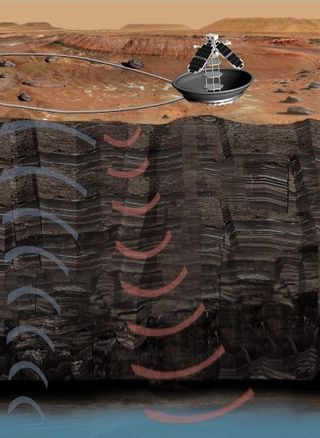Scientists eye the Martian underground in search for alien life
The subsurface offers a protected, and possibly habitable, environment.

The search for present-day life on Mars is heating up. And for good reason: An improved knowledge of Mars' geologic diversity and history, a better appreciation of life in extreme environments here on Earth, and a sharp focus on sensitive life-detection measurement methods are all bolstering the Mars-life hunt, giving scientists more reason to think that they just might find something.
Still, the issue of life on Mars demands new scientific concepts and knowledge concerning where to explore on the Red Planet and what to measure.
Related: The search for life on Mars (a photo timeline)
Astrobiologists and other experts tackled some of these issues last November during a conference at the National Cave and Karst Research Institute in Carlsbad, New Mexico.
On the meeting agenda was a discussion of how best to test for extant life on Mars, with or without the benefit of collection systems. Such systems include a complex and pricey Mars sample-return effort that officially kicks off this summer with the launch of NASA's Mars 2020 rover.
Geological environments

Conference attendees generally agreed that the best places to look for extant Mars life are in the deep subsurface caves, and in salt and ice.
While the cold, dry surface of Mars, with its harsh radiation environment, is widely considered to be uninhabitable, the subsurface has been hypothesized to be a viable, long-lived habitable environment, protected from the punishing surface conditions of Mars and a place where water could be stable.
Get the Space.com Newsletter
Breaking space news, the latest updates on rocket launches, skywatching events and more!
Vlada Stamenković, a research scientist at NASA's Jet Propulsion Laboratory in Pasadena, California, backed the underground approach at the conference.
"The surface of Mars is a very oxidizing, radiation-heavy environment where liquid water is not really stable for an extended amount of time," Stamenković said. "It's the worst place to look for life-sites on Mars. Groundwater might be the only habitat for extant life on Mars, if it still exists today."
To that end, Stamenković outlined at the meeting two potential Mars lander missions: Volatiles And Life: Key Reconnaissance & In-situ Exploration (VALKYRIE) and TH2OR (Transmissive H2O Reconnaissance), a small impact-lander platform that would remotely sense and study liquid subsurface groundwater via low-frequency electromagnetic waves. (Stamenković is the TH2OR principal investigator.)
Lava tubes, cave entrances
Over the years, researchers have spotted pit craters on the surface of Mars. These features are locations where the roof of a lava tube has partially collapsed and created a "skylight."
Researchers at the meeting pointed out that Mars-circling spacecraft have imaged numerous potential cave entrances. Shielded underground as they are, could lava tubes be prime microbial real estate on Mars?
Here on Earth, cave-exploring scientists have gathered evidence of microbial activity in the form of biofilms, slime, and microbially induced or precipitated minerals. Conditions in caves, the researchers have found, are typically far different, more consistent and more benign than on the surface.
Related: Photos: Mars caves and lava tubes

Systematic campaign
"It's pretty clear to me that there's much to be done to seek extant life, and certainly extinct life, in a variety of environments on Mars," said Penny Boston, senior advisor for science integration at NASA's Ames Research Center in Mountain View, California.
As an astrobiologist, Boston has been a "cave diver" for some 25 years. "I think we all recognize that there's not just a single way to go" to search for life on Mars, she told Space.com.
"My own personal opinion is that it's time to line up missions with what the community is seeing in terms of return on investment versus the difficulty of accessing any particular environment," Boston said. "It has been shown, with Mars, a campaign to systematically look for the water and now probe other aspects of habitability have yielded a tremendous amount of science."
And caves aren't as dangerous to explore as some people think, she added.
"I think people are often leery of the idea, because they may think of caves as mines. Mines are dangerous because we've recently made those mines and they are shored up by human structure," Boston said.
"But in the case of natural caves, they have had geologically long periods of time to stabilize," she added. "It's probably more likely that a cathedral is going to collapse on you than a natural cave. There are some exceptions to this. Obviously, caves in a pretty seismically active area, you'd have to be more leery."
Related: Ancient Mars could have supported life (photos)
"Air apparent" biosignature
Caves are some of the most exciting environments in the search for signs of present and past life on Mars, said Kevin Webster, a research scientist at the Planetary Science Institute in Tucson, Arizona.
Webster is studying cave air as a biosignature, looking into the concentration of trace gases in caves he has measured across the United States.
When thinking about caves on Mars, a biological signature might come in the form of the removal of reactive components from the atmosphere, Webster explained. Researchers have found several candidates for lava tube caves on Mars and continue to detect them. The exploration and the measurement of cave air on Mars might be pursued through either remote means or on-the-spot methods, he said.

How life may be operating
Biosignatures in the air offer a way to search for life that does not depend on genetics "but something that is broad enough to how life may be operating, even if it doesn't share our same biochemistry," Webster said.
So, Martian caves should be pursued, Webster said.
"I have spent my time trying to develop one particular biosignature that people may use in the search for life," Webster told Space.com. "I'm trying to understand how cave air differs from that of the atmosphere on Earth and why we might want to look at that on Mars. I love seeing new ways to find life. That's really exciting and in the vein of what I've been doing."
Leonard David is the author of the book "Moon Rush: The New Space Race," published by National Geographic in May 2019. A longtime writer for Space.com, David has been reporting on the space industry for more than five decades. Follow us on Twitter @Spacedotcom or Facebook.
OFFER: Save at least 56% with our latest magazine deal!
All About Space magazine takes you on an awe-inspiring journey through our solar system and beyond, from the amazing technology and spacecraft that enables humanity to venture into orbit, to the complexities of space science.
Join our Space Forums to keep talking space on the latest missions, night sky and more! And if you have a news tip, correction or comment, let us know at: community@space.com.

Leonard David is an award-winning space journalist who has been reporting on space activities for more than 50 years. Currently writing as Space.com's Space Insider Columnist among his other projects, Leonard has authored numerous books on space exploration, Mars missions and more, with his latest being "Moon Rush: The New Space Race" published in 2019 by National Geographic. He also wrote "Mars: Our Future on the Red Planet" released in 2016 by National Geographic. Leonard has served as a correspondent for SpaceNews, Scientific American and Aerospace America for the AIAA. He has received many awards, including the first Ordway Award for Sustained Excellence in Spaceflight History in 2015 at the AAS Wernher von Braun Memorial Symposium. You can find out Leonard's latest project at his website and on Twitter.
-
rarchimedes If life's signature cannot be detected from the mouth of a cavern it will require drilling into or driving into the cave. Finding a cave with a drivable entrance seems possible, but requires a level of driving around and checking that is not likely to happen before there are people who can walk in where their vehicle could not go. We might get lucky and find an accessible cave entrance on our first few tries within driving distance for our current crop of vehicles. Then there is the problem of communication. With the amount of iron in Martian soil, it seems unlikely that our vehicle could communicate from within a cave. It would have to move into the cave under its own programs and extricate itself from any problem in the cave without external assistance and then report its findings on exit from the cave.Reply
Without some major upgrades to robotic explorers, we shall have to wait for humans to arrive with testing equipment adequate to detect signs of life, past or present. Of course, that will raise significant further doubts about what is native and what is contamination. Can you imagine trying to keep everything surgically clean after X months in a tin can flying through space and then being largely limited to that same tin can once reaching Mars. If it is technically possible, can you imagine how much those people would want to escape into a cave with a bit of room, contamination or no. They would probably need to pick another cave for testing after they had a chance to clean themselves up in the first cave.
That was a little tongue in cheek, but not by far. If they are going to be exposed for another 600+ days at the very least, they will need to spend a big chunk of that under some significant shielding, either piled up Mars dirt, or in one of those many caves. Anybody not planning for that isn't serious about actually living on Mars for one Mars year or a lifetime. Since the caves don't require any construction, I would vote for them. -
Rover Wiens Replyrarchimedes said:If life's signature cannot be detected from the mouth of a cavern it will require drilling into or driving into the cave. Finding a cave with a drivable entrance seems possible, but requires a level of driving around and checking that is not likely to happen before there are people who can walk in where their vehicle could not go. We might get lucky and find an accessible cave entrance on our first few tries within driving distance for our current crop of vehicles. Then there is the problem of communication. With the amount of iron in Martian soil, it seems unlikely that our vehicle could communicate from within a cave. It would have to move into the cave under its own programs and extricate itself from any problem in the cave without external assistance and then report its findings on exit from the cave.
The first exploration of a Mars cave will be with a drone. The Mars 2020 rover will deliver a tech demo helicopter to the surface of Mars next year at this time. If that small version (1.2 m blade-span) works, larger ones will be planned, even though Mars is a tough place to fly, with its thin atmosphere. A drone (or quad-copter) is a perfect way to do initial reconnaissance of a Mars skylight cave (e.g., a ceiling hole in a large lava tube). The copter can fly in, do reconnaissance, and return outside the cave to transmit data and re-charge. We've developed a sensitive, lightweight instrument to do an aerial search for organic materials inside of a Mars cave. The drone never needs to land in the cave for this kind of a search. We submitted a mission concept to NASA using a helicopter equipped with this "OrganiCam" to do just this kind of search. The mission is called LIFE COVE. This kind of idea seems logical for the first survey mission inside of a Mars cave, and it is basically feasible now. -
rarchimedes A drone makes sense, but is going to need ultrasonic or lidar or radar sensors to maneuver in the cave and return. Power usage is going to be a major consideration for all of the instrumentation because it takes so much energy just to fly in that atmosphere. There is some possibility that the atmosphere will be colder and denser within the cave, making the flight in the cave easier than above the external surface. There is also the possibility that the temperature in the cave will be so cold that atmosphere in the cave will have frozen onto the floor of the cave, making flight much beyond the entrance area, impossible. Obviously, this is all speculation, but I don't think any of it is completely unreasonable.Reply












